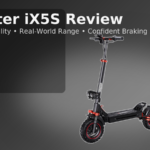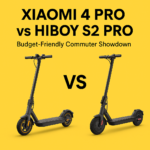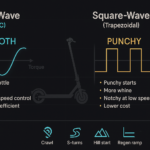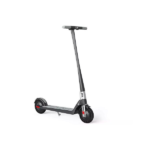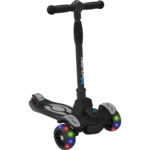- Home
- Scooters
- Electric Scooters
- Apollo Explore 2.0
Apollo Explore 2.0
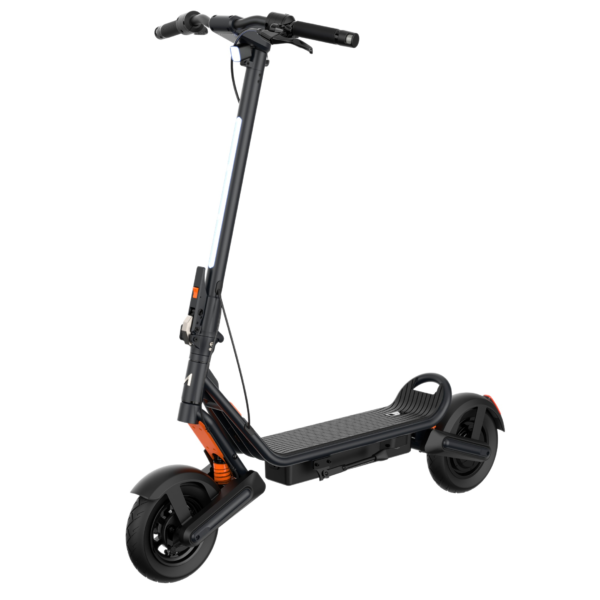

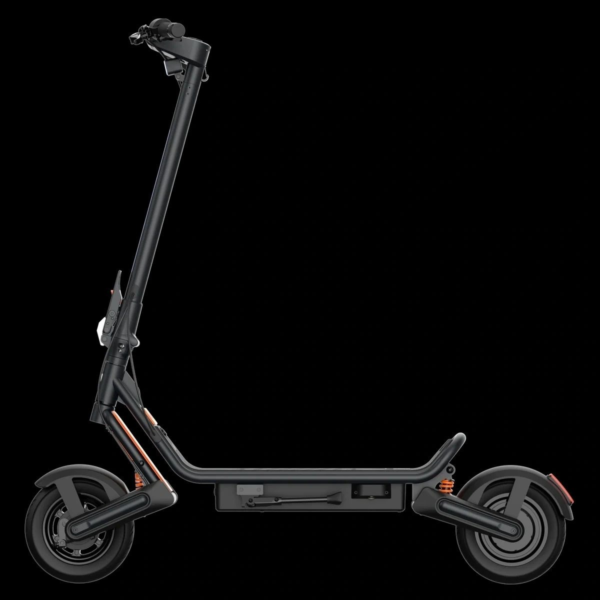
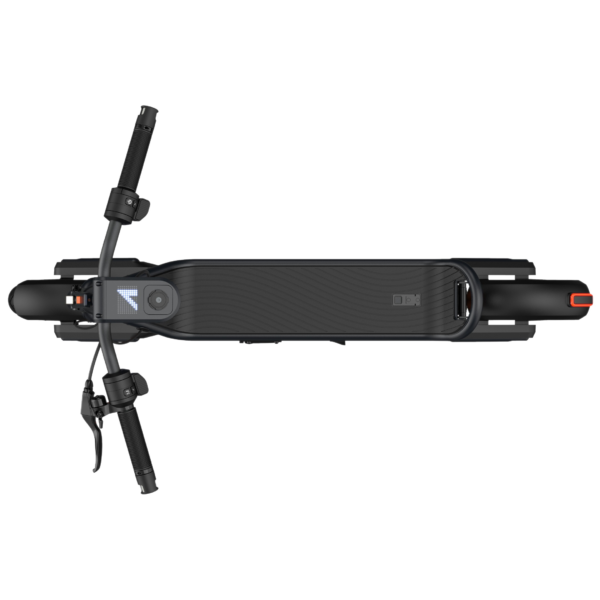
- Battery Range: 37 miles (60 km)
- Top Speed: 25 mph (40 km/h)
- Motor Power: 1600 W peak (single motor)
- Weight Capacity: 265 lb (120 kg)
- Charging Time: ~8 h
- Scooter Weight: 60.0 lb (27.2 kg)
PROS
- IP66 water resistance
- Triple-spring suspension
- Drum + strong regenerative braking
- 10″ self-healing tubeless tires
- Apollo app + phone-as-display
- UL2271/2272 safety certifications
CONS
- Single mechanical brake (drum) may feel different than discs
- No published folded dimensions
- Heavier than many entry commuters
Table of contents
- What Is the Apollo Explore 2.0?
- How the Apollo Explore 2.0 Works
- Key Specifications
- Design & Build Quality
- Performance Fundamentals
- Battery, Range & Efficiency
- Ride Quality & Comfort
- Braking & Safety Features
- Portability & Daily Usability
- Maintenance & Care
- Weather & Seasonal Considerations
- Apollo Explore 2.0 vs Alternatives
- Who the Apollo Explore 2.0 Is (and Isn’t) For
- FAQs
- Glossary
- Final Notes on Real-World Use
The Apollo Explore 2.0 is a single-motor, city-first electric scooter built to deliver serious punch without the heft or complexity of dual-motor machines. It blends torque-rich acceleration, a long-life battery, and low-maintenance braking into a commuter package that still feels playful after work. If you want an everyday ride that’s quick, smooth, and confidence-inspiring—yet still easy to live with—the Explore 2.0 hits that sweet spot.
What Is the Apollo Explore 2.0?
The Apollo Explore 2.0 is Apollo’s reimagined mid-class commuter scooter. It’s designed for riders who want real-world speed and range in a durable chassis but prefer the simplicity of a single rear hub motor. With a 48 V pack using 21700 cells in an IP66-sealed, UL-certified enclosure, triple-spring suspension, self-healing tubeless tires, and a front drum plus regenerative braking, it prioritizes reliability and everyday ease as much as outright performance. The cockpit includes a DOT-style display and deep app integration for tuning throttle response, regen feel, and ride modes.
How the Apollo Explore 2.0 Works
Electric scooters share a common recipe, but the Explore 2.0’s ingredients are tuned with commuters in mind.
- Motor: A rear hub motor delivers up to 1,600 W peak output. Because it’s in the wheel, there are no chains or belts, which keeps noise low and maintenance simple. Think of it like a quiet, instant-response turbine that lives inside the rear hub.
- Controller: Apollo’s MACH controller (rated to 30 A) manages power delivery. It decides how quickly the scooter ramps up torque when you press the throttle. The calibration here matters; it’s what makes the Explore 2.0 feel snappy off the line yet controllable in traffic.
- Battery: A 48 V, 13.5 Ah pack (about 648 Wh) stores energy. Built with 21700 cells and protected within an IP66 enclosure, it’s designed for longevity and safety (battery system certified to UL2271). Expect stronger voltage sustain under load compared to small-cell packs.
- Throttle: An ergonomic thumb throttle lets you modulate power without wrist strain. Small inputs translate to predictable acceleration, which helps with low-speed control around pedestrians and at intersections.
- Brakes: The Explore 2.0 pairs a front drum with Power RBS™ regenerative braking. You’ll feel a smooth deceleration as the motor converts momentum back into charge. Because regen handles most slowing, the mechanical system stays cleaner and wear remains low.
Key Specifications
The table below organizes the official specifications into clear blocks for quick scanning; values are presented in both imperial and metric units where applicable.
General
| Item | Detail |
|---|---|
| Model year / class | 2025 / commuter-performance single-motor |
| Max rider load | 265 lb (120 kg) |
| Water resistance | IP66 (scooter), battery enclosure IP66 |
| App features | Ride modes, regen level, lighting controls, stats, lock, and more |
| Display | DOT-style built-in; phone-as-display support |
Performance & Power
| Item | Detail |
|---|---|
| Motor | Single rear hub; 1,600 W peak (controller-limited for torque and efficiency) |
| Top speed | 25 mph (40 km/h) |
| 0–15 mph | Under 3 s (claimed) |
| Hill climb | Up to 25° grades (short urban hills) |
| Controller | MACH controller, ~30 A |
| Riding modes | Eco, Normal, Sport / Ludo (unlocks max acceleration/top speed) |
Battery, Charging & Electrical
| Item | Detail |
|---|---|
| Battery | 48 V, 13.5 Ah (≈ 648 Wh), 21700 cells, UL2271 battery certification |
| Range (ideal) | Up to 37 mi (60 km) in Eco mode |
| Standard charger | 54.6 V, 1.5 A; ~8 h full charge |
| Optional fast charge | ~3 h (using compatible fast charger) |
| Regen | Power RBS™; up to ~10% recovery depending on terrain and usage |
| Lighting | 360° package: headlight, stem/body lights, brake light, front/rear signals |
Build & Dimensions
| Item | Detail |
|---|---|
| Frame | Welded steel |
| Tires | 10-inch tubeless, self-healing (PunctureGuard™) |
| Suspension | Triple spring (front + dual rear) |
| Ground clearance | ~6 in (≈ 15 cm) |
| Weight | 60 lb (≈ 27 kg) |
| Unfolded size | 50 L × 26.6 W × 51 H in (≈ 127 × 67.6 × 129.5 cm) |
| Folded size | 50.0 L × 26.8 W × 23.6 H in (≈ 127 × 68 × 60 cm) |
Safety & Control
| Item | Detail |
|---|---|
| Brakes | Front drum + regenerative (Power RBS™) |
| Visibility | 360° lighting + turn signals; rear fender beam |
| Traction | Street-tread 10″ tubeless tires for wet/dry grip |
| Compliance | UL-certified system components; water/dust protection rated IP66 |
Features & Extras
| Item | Detail |
|---|---|
| Ride modes | Eco / Normal / Sport (Ludo) |
| App tuning | Throttle feel, regen level, lights, ride data |
| Phone mount | DOT display + phone-as-display support |
| Cruise Control | App-configured on many Apollo models (availability may depend on firmware) |
Warranty & Compliance
| Item | Detail |
|---|---|
| Warranty | 12-month limited coverage on major components |
| Frame coverage | Up to 10,000 km (≈ 6,250 mi) |
| Battery safety | UL2271 battery; IP66-sealed enclosure |
| Notes | Local e-scooter laws vary by region; ride responsibly |
Design & Build Quality
The Explore 2.0 feels purpose-built for city miles. The welded steel frame has a planted, monolithic character, and the widened, lengthened deck gives your stance room to breathe. Tall riders often feel cramped on compact scooters; here, the extra deck space eases foot placement so you can square up or stagger as traffic demands. Because the tires are tubeless and pre-filled with sealant, the day-to-day experience skews “grab and go,” not “pump and patch.”
The cockpit keeps information simple. The DOT-style display remains legible in daylight thanks to anti-glare treatment, while the thumb throttle sits exactly where your hand expects it. Because the regen control is integrated and progressive, you can modulate speed with a finger rather than constantly squeezing a lever. That reduces hand fatigue over longer commutes. And since the lighting is 360°, you’re visible from ahead, behind, and the sides—useful when lane-splitting bike traffic or crossing intersections at dusk.
Fit-and-finish reflects Apollo’s maturing design language. Cable routing is tidy, hardware is robust, and body panels feel solid at touch points. You won’t find rattly latches or flexy folding parts when properly adjusted. The overall impression is of a scooter that invites daily use and shrugs off typical city scuffs.
Performance Fundamentals
Off-the-line acceleration is where the Explore 2.0 makes its case. In Sport/Ludo, the scooter steps smartly from a standstill, reaching 15 mph in under three seconds. The key is how the MACH controller shapes the power curve. It feeds in current quickly enough to feel lively, yet predictably enough that you don’t upset balance at low speeds. In Normal mode, launches soften for smoother neighborhood riding; Eco trims peak power even further for efficiency.
Cruising stability remains excellent up to its capped top speed of 25 mph (40 km/h). The triple-spring suspension manages potholes, curb cuts, and expansion joints without bouncing you off line. Because the deck is longer, weight distribution feels natural—there’s room to shift your hips and settle into a neutral stance, which helps stability at speed.
Hill-climb behavior over 7–10% grades is confident for a single motor. Short, steep ramps are dispatched without drama; longer climbs are best attacked in Sport/Ludo to maintain momentum. You’ll feel voltage sag less with the 21700-cell battery under moderate loads than on small-cell packs, which keeps the scooter from feeling winded halfway up a hill. For truly sustained, steep ascents, plan to carry a bit more speed into the grade and keep cadence steady.
Battery, Range & Efficiency
On paper, the Explore 2.0’s 48 V, 13.5 Ah (≈ 648 Wh) pack delivers up to 37 mi (60 km) in ideal, Eco-mode conditions. Real-world range varies. Rider weight, tire pressure, wind, temperature, elevation, and average speed all play large roles. Heavier riders cruising at high speeds on cold days will see less; lighter riders who flow with traffic around 12–18 mph (20–30 km/h) will come closer to the claimed figure.
Regenerative braking adds efficiency. If you plan your commuting rhythm—coasting early, easing into regen instead of relying on mechanical bite—you’ll harvest small gains every stoplight. Over a week, those gains compound. Expect roughly single-digit percentage returns in typical city riding, with higher returns on rolling routes that encourage frequent, gentle deceleration.
Charging best practices:
- Use the 54.6 V, 1.5 A standard charger for overnight top-ups; budget ~8 hours from low state of charge.
- When time matters, a compatible fast charger cuts that to ~3 hours.
- Avoid storing the pack fully discharged or fully full for long periods; for multi-day storage, ~40–60% is a healthy window.
- In winter, bring the scooter (or battery area) into a mild environment before charging so the pack isn’t cold-soaked.
- Do periodic full cycles to let the battery management system re-calibrate state-of-charge accuracy.
Ride Quality & Comfort
Comfort starts with the triple-spring suspension and 10″ tubeless tires. Springs flatten sharp-edged hits while the larger tire diameter smooths chatter. Because the tires are tubeless and pre-sealed, puncture anxiety fades and the casings can run slightly higher pressures without going harsh. The result is a composed ride that remains lively rather than floaty.
Ergonomics are dialed for urban usage. The thumb throttle’s light action pairs well with regen modulation, so you can feather speed with minimal hand movement. The deck’s extra length lowers fatigue by letting you change stance often. Notably, stem flex is well controlled; there’s just enough give to take the sting out of harsh impacts while resisting wobble at speed when your weight is centered over the deck.
On mixed surfaces—pavers, worn asphalt, painted bike lanes—the street-tread rubber maintains predictable grip. Wet steel plates or damp leaves still demand caution, of course; roll off the throttle before slick sections and let regen scrub speed early.
Braking & Safety Features
The Explore 2.0’s everyday superpower is low-maintenance stopping. Power RBS™ regen does the lion’s share of work in typical commuting, turning your deceleration into battery trickle-charge. The front drum sits ready as a mechanical backup with consistent, weather-proof performance. Unlike disc systems, drums hide from road grit and hold their tune longer, which suits riders who prefer to ride more and wrench less.
Braking feel builds progressively. Light thumb pressure yields a gentle slow, perfect for creep-speed control in crosswalks. Press deeper and decel ramps decisively without skidding the front. Because regen matches suspension motion, the scooter stays planted over broken pavement while you’re slowing down.
Visibility is strong. A forward headlight throws a wide beam for night streets, while stem and deck-level body lights make side-on presence obvious. Add in front and rear turn signals plus a rear brake light and you’ve got a true 360° signature that stands out in traffic. The IP66 rating further bolsters safety by keeping water and dust away from critical electronics.
Portability & Daily Usability
At 60 lb (≈ 27 kg), the Explore 2.0 is solid but manageable for short carries—up a few stairs, into an elevator, or on/off a train platform. The folding mechanism brings the handlebar down to ~23.6 in (60 cm) tall in the folded position, which helps it slide under desks or into a hatchback trunk. Wide deck rails offer natural hand-holds if you prefer a two-handed carry.
For storage, favor a dry spot with moderate temperature. Because lighting is integrated and robust, you can plug in, set a charge timer, and park without fuss. For security, combine a quality U-lock or folding lock around the frame with a cable through a wheel if you must leave it outside. As always, remove add-ons like phone mounts when unattended.
Maintenance & Care
One of the Explore 2.0’s advantages is minimal routine upkeep. However, a light schedule keeps it feeling factory-fresh.
Before each ride (30 seconds):
- Check tire visual condition; top up pressures as needed (consult sidewall; typical 10″ tubeless commuter tires land around 35–50 psi / 2.4–3.4 bar depending on rider weight and comfort).
- Quick brake function check (roll the scooter and engage regen; squeeze the lever to verify mechanical backup).
Weekly (or every ~50 miles / 80 km):
- Inspect fasteners at stem, folding joint, and axle nuts; verify nothing is loosening.
- Wipe the deck and lights, especially after rain; clear debris from tread.
Monthly:
- Deeper bolt torque check on stem clamp and handlebar hardware.
- Evaluate brake drum linkage free-play and lever feel; adjust per the manual if needed.
- Review app for firmware updates; many include refinements to throttle, lighting, and regen behavior.
Seasonally:
- Inspect tire tread depth and sidewall cuts; rotate or replace if wear is uneven.
- Clean and re-grease folding mechanism if your area uses road salt.
- Perform a full battery calibration cycle (gentle run from ~90% down to ~15–20%, then charge to 100% without interruption).
Weather & Seasonal Considerations
The Explore 2.0’s IP66 rating means it’s built to handle wet commutes and dusty roads. Even so, ride judgment matters.
- Rain: Reduce speed, brake earlier with regen, and avoid painted lines or metal surfaces that spike slip risk. After the ride, wipe the scooter and give the brake linkage a quick dry.
- Heat: Batteries are happiest when kept cool. Park in shade when possible and let the pack rest before charging after a hard, hot run.
- Cold: Expect reduced range. Warm the scooter indoors before charging and consider higher tire pressures if soft surfaces and potholes are rare; otherwise keep comfort first.
- Storage: For multi-week pauses, store around 40–60% state of charge and in a dry, temperate spot.
Apollo Explore 2.0 vs Alternatives
The Explore 2.0 sits between entry-level commuters and heavy dual-motor performance machines.
- Versus budget commuters: It offers significantly more torque, richer lighting, bigger deck space, and better suspension. Those upgrades translate into safer merges, less fatigue, and calmer handling on rough streets.
- Versus lightweight last-mile scooters: It’s heavier and not as tossable, yet the stability and braking headroom make daily rides less stressful. If you face mixed traffic or rolling hills, the Explore 2.0’s reserve matters.
- Versus high-power dual-motors: Top-end speed and uphill dominance go to the duals. Nevertheless, the Explore 2.0 counters with lower maintenance, easier carrying, and friendlier battery consumption. You get much of the “feel fast” sensation without taking on big-scooter bulk.
- Versus off-road-leaning models: Knobby tires and long-travel suspension win on dirt, but the Explore 2.0’s street-tuned rubber and triple springs are the better match for potholes, curbs, and painted lanes.
In short, the Explore 2.0 shines for riders who prioritize urban agility, solid range, and a maintenance-light routine over highest-possible speed.
To see what’s coming next in this class, check out the most anticipated electric scooters launching in 2025 for added context on where mid-class commuters are headed.
Who the Apollo Explore 2.0 Is (and Isn’t) For
Great for:
- Daily commuters who want brisk acceleration for traffic gaps and strong, predictable braking.
- Students and city riders who appreciate an all-weather rating, bright lighting, and a comfortable deck for longer days.
- Multi-modal travelers who need a scooter that folds compactly enough for trains, rideshares, and small elevators.
- Riders who dislike wrenching and prefer regen-heavy braking and self-healing tires.
Think twice if:
- You demand above-25 mph cruising or plan frequent long, steep climbs. A dual-motor platform may fit better.
- You need ultra-light last-mile portability. At 60 lb, the Explore 2.0 is sturdy rather than featherweight.
- You want heavy off-road focus. Street-tread tires and city-calibrated suspension favor asphalt.
FAQs
1) Is the Explore 2.0 fast enough for city commuting?
Yes. It reaches 25 mph (40 km/h), which is plenty for bike lanes and urban arterials where consistency, braking, and visibility matter more than outright top speed.
2) How far can I ride on one charge?
In Eco mode and ideal conditions, up to 37 mi (60 km). Most riders will see less in mixed traffic, cold weather, or hilly routes. Smart use of regen helps stretch range.
3) Does the Explore 2.0 handle rain?
It’s rated IP66, so it’s built for wet commutes. Still, slow down on slick surfaces and dry the scooter after riding in the rain.
4) How much maintenance does it need?
Very little. Tubeless self-healing tires plus regen-first braking mean fewer pad changes and flats. Do periodic bolt checks, pressure checks, and firmware updates.
5) Can I climb steep hills?
Yes, short ramps up to 25° are within its envelope. For longer climbs, use Sport/Ludo mode and carry some speed into the grade.
6) What’s included in the warranty?
Major components carry a 12-month warranty, and the frame is covered up to 10,000 km (6,250 mi). Always keep receipts and follow the maintenance basics.
7) Where can I find an “Apollo Explore 2.0 overview” in one place?
You’re reading it—this article consolidates the core details, ride impressions, and ownership tips in a single, easy reference.
Glossary
- Ah (Amp-hour): Battery capacity measurement. Higher Ah generally means more stored energy at the same voltage.
- Wh (Watt-hour): Capacity × voltage; a direct proxy for total energy.
- Controller: The scooter’s “brain” that regulates current flow to the motor for smooth acceleration.
- Regen (Regenerative braking): Using the motor to slow the scooter and recharge the battery.
- Stem flex: The small, controlled give in the steering column; can improve comfort but too much hurts stability.
- IP rating: Ingress Protection; IP66 means dust-tight and protected against strong water jets.
- Deck: The platform where you stand; size and grip influence comfort and control.
- Hub motor: A motor built into the wheel hub; quiet, compact, and low-maintenance.
- Torque: The rotational force from the motor; more torque equals better launches and hill starts.
- Ludo (Sport) mode: A high-output mode that unlocks quicker acceleration and the full top speed.
- BMS: Battery Management System; protects against over/under-voltage, over-current, and temperature extremes.
- Self-healing tire: Tubeless tire with sealant that can close small punctures as you ride.
- Drum brake: Enclosed brake type that resists weather and contamination, requiring less frequent service.
- DOT display: High-legibility display designed for clarity and glare resistance.
- Ground clearance: The space between deck bottom and the ground; more clearance helps with curbs and bumps.
Final Notes on Real-World Use
Commuters often judge a scooter by feel more than figures. The Explore 2.0’s feel is coherent: the MACH controller delivers torque that you can meter precisely; the triple-spring hardware and larger tubeless casings soak up rough patches; and the lighting suite keeps you seen from all angles. Meanwhile, regen takes daily wear off the mechanical brake and returns a bit of energy to the pack—small advantages that accumulate over months of riding.
As with any scooter, range is a system result rather than a single number. Keep tire pressures in the sweet spot, ride in the smoother middle of the throttle, and time regen instead of waiting for last-second braking. Those habits pay you back in calmness, safety, and miles.
Specifications
General
| Model The Model specifies the exact version or name of the scooter. It helps identify its unique design, features, and specifications within the manufacturer’s product line. Knowing the model makes it easier to compare options, find compatible accessories, or look up support information. | Explore 2.0 |
| Brand The Brand identifies the manufacturer or company that designs and produces the scooter. A trusted brand is a sign of quality, reliability, and good customer support. Well-known brands often have higher standards for safety, performance, and after-sales service, giving you more confidence in your purchase. | Apollo |
| Release Date The Release Date indicates when the scooter model was officially launched on the market. This helps you know how current the design, technology, and features are. A newer release date often means updated components, improved performance, and the latest safety or smart features. | 17 November 2025 |
| Recommended Age Recommended Age indicates the minimum age range that the scooter is designed for, based on safety, size, and ease of use. Following the recommended age helps ensure that riders can handle the scooter’s speed, weight, and controls comfortably and safely. Always check local laws and use protective gear, especially for younger riders. | +18 |
Performance & Power
| Motor Power (Wattage) What it means: The motor power, measured in watts (W), shows how strong the scooter’s electric motor is. Why it matters: Higher wattage usually means better acceleration, more torque, and improved performance on hills or rough terrain. For example, a 250W motor is good for flat city roads and light riders, while a 500W or 1000W motor provides more power for faster speeds or climbing steep inclines. | Single rear hub motor with MACH controller, 1600 W peak |
| Top Speed The Top Speed indicates the maximum speed that the scooter can reach under optimal conditions. It’s usually measured on level ground with a fully charged battery and an average rider weight. A higher top speed allows you to travel longer distances faster, but always ensure you ride within legal speed limits and your personal comfort zone for safety. | 25 mph (40 km/h) |
| Battery Capacity Battery Capacity refers to the total amount of energy the scooter’s battery can store, usually measured in ampere-hours (Ah) or watt-hours (Wh). A higher battery capacity means you can ride longer distances on a single charge, reducing the need for frequent recharging. Keep in mind that actual range can vary depending on rider weight, terrain, speed, and weather conditions. | 48 V 13.5 Ah (~648 Wh) |
| Estimated Range per Charge The Estimated Range per Charge indicates the average distance the scooter can travel on a single full battery charge. This range is calculated under optimal conditions, such as flat terrain, moderate speed, and average rider weight. Real-world range may vary depending on riding style, terrain, weather, and load. A longer range means fewer recharges and greater freedom for longer trips. | 37 miles (60 km) |
| Hill Climb Ability Hill Climb Ability describes the maximum incline or slope that the scooter can handle while maintaining stable performance. It’s typically expressed as a percentage or in degrees. A higher hill climb rating means the scooter can tackle steeper hills without losing too much speed or power. Actual climbing performance may vary based on rider weight, battery charge, and terrain conditions. | 25% |
| Drive System The Drive System refers to how power from the motor is delivered to the wheels. Electric scooters typically use either a hub motor (directly integrated into the wheel) or a chain/belt drive system. A high-quality drive system ensures smooth acceleration, efficient power transfer, and low maintenance. The choice of drive system affects performance, noise level, and overall ride experience. | RWD |
Charging & Electrical
| Charging Time Charging Time indicates how long it takes to fully recharge the scooter’s battery from empty to 100% using the standard charger provided. Faster charging means less downtime and more time on the road. Actual charging time may vary slightly depending on battery capacity, charger output, and environmental conditions. | Approx. 8 hours (54.6V 1.5A charger) |
| Battery Type Battery Type refers to the specific technology used in the scooter’s battery, which affects performance, lifespan, weight, and charging time. Most modern electric scooters use high-quality lithium-ion (Li-ion) batteries because they offer a good balance of energy density, durability, and low maintenance. A reliable battery type ensures consistent power delivery and longer riding ranges. | Lithium-ion with Smart BMS |
| Removable Battery A Removable Battery means the battery pack can be easily detached from the scooter for convenient charging and replacement. This feature allows you to charge the battery separately, swap it with a spare for extended range, or securely store it indoors in extreme weather. Removable batteries add flexibility and make it easier to keep your scooter powered up wherever you are. | No |
| Regenerative Braking Regenerative Braking is an energy-saving feature that converts some of the energy normally lost during braking back into battery power. When you slow down or brake, the motor works in reverse to generate electricity, which helps extend the scooter’s range and improves overall efficiency. This system also reduces wear on traditional brake components, leading to lower maintenance over time. | Yes (Power RBS™ regenerative braking) |
| Lighting Lighting refers to the built-in front and rear lights that enhance visibility and safety when riding in low-light conditions or at night. Good lighting helps you see the road ahead and ensures that other road users can see you. Many scooters include LED headlights, taillights, and sometimes brake lights or side reflectors for added safety and compliance with local traffic regulations. | High-output headlight, stem beam, body lights, front/rear turn signals, brake light |
Build & Dimensions
| Scooter Weight Scooter Weight refers to the total weight of the scooter when fully assembled, including the battery. This affects how easy it is to carry, lift, and store the scooter when not in use. A lighter scooter is more portable and convenient for commuting, especially if you need to carry it upstairs or onto public transport. Keep in mind that a sturdy frame and quality components may add to the weight but also contribute to better durability and ride stability. | 60.0 lb (27.2 kg) |
| Maximum Rider Weight Maximum Rider Weight indicates the highest rider weight that the scooter is designed to safely support while maintaining optimal performance and stability. Staying within this limit helps ensure reliable acceleration, braking, and climbing ability, and it protects the frame, suspension, and motor from excessive strain. Exceeding the recommended limit may reduce performance and increase wear on components. | 265 lb (120 kg) |
| Deck Size Deck Size refers to the dimensions of the scooter’s standing platform. A wider and longer deck provides more foot space, allowing you to stand comfortably and adjust your stance while riding. A well-sized deck improves balance and stability, especially on longer rides or at higher speeds. Compact decks, on the other hand, help keep the scooter lightweight and portable. | XL deck; welded steel frame |
| Handlebar Height Handlebar Height refers to the distance from the deck to the handlebars, which affects your riding posture and comfort. An appropriate handlebar height helps you maintain good balance, reduces strain on your back and arms, and makes steering more comfortable. Some scooters have adjustable handlebars to fit riders of different heights, while others have a fixed height for a streamlined design. | Fixed; scooter size 51 in H |
| Folding Mechanism The Folding Mechanism describes how easily and securely the scooter can be folded for carrying and storage. A well-designed folding system lets you quickly collapse the scooter into a compact size, making it convenient to transport on public transit, store under a desk, or fit into a car trunk. Look for sturdy latches and safety locks to ensure the scooter stays firmly in place when folded or unfolded. | Folding stem clamp |
| Dimensions Folded Dimensions indicate the size of the scooter when it’s fully folded. This measurement shows how much space the scooter will take up when stored or carried, making it easier to check if it will fit in your car trunk, under a desk, or in a closet. Compact folded dimensions are ideal for commuters who need to bring their scooter on public transport or store it in tight spaces. | Unfolded: 50 × 26.6 × 51 in (L×W×H); Folded: Not specified |
| Material Material refers to the primary construction materials used for the scooter’s frame and key components. High-quality materials like aircraft-grade aluminum, reinforced steel, or durable composites provide strength, stability, and a lighter overall weight. A sturdy material ensures the scooter can handle daily wear and tear while maintaining safety and performance. | Welded steel frame |
Safety & Control
| Brake Type(s) Brake Type(s) describe the braking systems the scooter uses to help you slow down or stop safely. Common brake types include mechanical brakes (like drum or disc brakes), electronic brakes, and foot brakes. Many scooters combine multiple braking systems for added safety and shorter stopping distances. The type and quality of brakes affect your control, especially when riding at higher speeds or on slopes. | Front drum + electronic regenerative braking |
| Suspension Suspension refers to the system that absorbs shocks and vibrations while riding, providing a smoother and more comfortable ride over uneven or rough surfaces. Scooters may have front suspension, rear suspension, or dual suspension for better shock absorption and stability. Good suspension helps reduce rider fatigue and improves control, especially when riding on bumpy roads or off-road paths. | Triple spring suspension (front & dual rear) |
| Tire Type Tire Type refers to the kind of tires the scooter uses, which directly affects ride comfort, traction, and maintenance. Common types include solid (airless) tires, pneumatic (air-filled) tires, or hybrid options. Pneumatic tires offer better shock absorption and a smoother ride on rough surfaces, while solid tires are puncture-proof and require less upkeep. The right tire type helps ensure safe handling and a comfortable ride in different conditions. | 10″ PunctureGuard self-healing tubeless |
| Tire Size Tire Size indicates the diameter and width of the scooter’s tires, which affect ride comfort, stability, and how well the scooter handles different terrains. Larger tires generally offer better shock absorption and a smoother ride over bumps and rough surfaces, while smaller tires keep the scooter lighter and more portable. Choosing the right tire size helps ensure a balance between agility and comfort. | 10-inch |
| Kickstand The Kickstand is a built-in stand that allows you to park your scooter upright when it’s not in use. A sturdy kickstand keeps the scooter stable and prevents it from tipping over, protecting it from scratches and damage. It also makes storing and accessing your scooter more convenient, whether you’re at home, work, or on the go. | Side kickstand |
| Water Resistance Rating Water Resistance Rating indicates how well the scooter is protected against water and moisture, usually shown as an IP (Ingress Protection) rating. This rating helps you understand whether the scooter can handle light rain, splashes, or wet roads without damage. While most scooters are not fully waterproof, a good water resistance rating adds peace of mind when riding in changing weather conditions. Always avoid deep puddles or submerging the scooter to protect its electrical components. | IP66 |
Features & Extras
| Display/Console The Display (or Console) shows important real-time information about your ride, helping you monitor your scooter’s status at a glance. Typical displays show speed, battery level, distance traveled, and riding mode. Some models also include additional features like Bluetooth connectivity, app integration, or backlighting for better visibility at night. A clear and easy-to-read display enhances safety and convenience on every trip. | D.O.T. built-in display + phone-as-display mount |
| Ride Modes Ride Modes refer to the different speed and power settings you can choose to match your riding style or road conditions. Common modes include eco for maximum range and energy efficiency, standard for everyday balance, and sport or turbo for higher speed and stronger acceleration. Switching between ride modes allows you to customize performance, conserve battery, and ride safely in various environments. | Eco/Normal/Sport (Ludo) |
| Smart App Connectivity Smart App Connectivity lets you pair your scooter with a dedicated mobile app via Bluetooth. Using the app, you can monitor real-time ride stats like speed, battery level, and range, adjust settings such as ride modes or cruise control, lock the scooter for added security, and sometimes receive firmware updates. This feature adds convenience and allows you to personalize your riding experience right from your smartphone. | Apollo App (locking, modes, ride stats, support) |
| Anti-Theft System The Anti-Theft System helps protect your scooter from unauthorized use or theft. This feature can include built-in alarms, electronic motor locks, GPS tracking, or remote locking through a mobile app. A good anti-theft system provides peace of mind when parking your scooter in public spaces, adding an extra layer of security to safeguard your investment. | App lock |
| Cruise Control Cruise Control allows you to maintain a steady speed without continuously holding the throttle. This feature makes longer rides more comfortable by reducing hand fatigue and providing a smoother, more relaxed riding experience — especially on flat, open roads or bike lanes. For safety, cruise control can usually be easily activated or deactivated while riding. | Yes |
| Accessories Included Accessories Included lists the additional items that come with the scooter to enhance your riding experience and convenience. Common accessories may include a charger, kickstand, bell, lights, phone holder, or carrying strap. These extras add value by making your scooter safer, easier to use, and ready to ride straight out of the box. | Scooter, 54.6V 1.5A charger, user manual |
Warranty & Compliance
| Warranty Period The Warranty Period indicates how long the manufacturer guarantees the scooter against defects in materials and workmanship under normal use. A good warranty provides peace of mind, showing the brand’s confidence in its product quality. Always check what parts are covered, such as the frame, battery, and motor, and follow the maintenance guidelines to keep your warranty valid. | 12 months (frame coverage to 10,000 km) |
| Certifications Certifications confirm that the scooter meets specific safety, quality, and environmental standards set by recognized organizations or regulatory bodies. Common certifications may include CE, RoHS, UL, or other local compliance marks, depending on your region. These certifications ensure that the scooter is manufactured to high standards and is safe and legal to use in your country. | UL2271/UL2272; EN17128; region-dependent |








